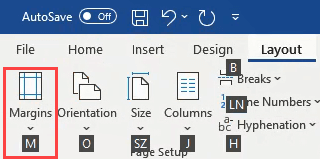

- #Word landscape one page only how to#
- #Word landscape one page only full#
- #Word landscape one page only windows#
#Word landscape one page only how to#
Now you know how to make a one-page landscape in a document. Word changes the orientation of one page to landscape, while all other pages remain in portrait orientation. Whole document: Apply the chosen orientation to all sections in the document.Ĭlick on Ok to close the Page Setup menu.This point forward: Apply the chosen orientation to all sections beyond the cursor.This section: Apply the chosen orientation to the section under the cursor.Under Preview, click on the down arrow next to Apply to. In the Page Setup menu, click on the Margins tab. Step #2: Open the page setup menuĬlick on the down arrow next to Page Setup. Position the document such that this page is in the middle of the three pages displayed. Navigate to the page for which you want to change the orientation. Then at the bottom, click the Apply To drop-down box and choose Selected Text. Method #2: Use the Page Setup menu Step #1: Open the Word document Go to the Layout tab and click the arrow on the bottom right corner of the Page Setup section of the ribbon. Word will modify the page and all the following pages to portrait orientation. Under the Layout tab, click on the small triangle below the Orientation icon. Introduce a continuous section break as in Step #2. Click the little arrow and choose Selected text. Now, look at the bottom of this box and you’ll see a submenu labeled Apply to. In here, look under Orientation and select Landscape.
#Word landscape one page only full#
Place the cursor at the beginning of the next page. However, you now need to click the little icon in its bottom-right corner which will open the full Page Setup menu. Step #4: Change orientation of the rest of the pages Word will modify the page and all the following pages to landscape orientation. Under the Layout tab, In the Page Setup section, click on the small triangle below the Orientation icon. Since you cant have more than one application in any window you also cant have simultaneous selections in Word. Remember this connection: Window -> Application -> Document -> Selection. And only the active one can have a selection.
#Word landscape one page only windows#
Under Section Breaks, click on Continuous. Even if you see several windows on your screen, only one of them can be active. Place the cursor at the beginning of the page that you want to change.Ĭlick on the Layout tab on the top menu bar to change the ribbon.Ĭlick on the small triangle next to Breaks. Step #2: Introduce a Continuous Section Break In the Zoom section, click on Multiple Pages.Ĭlick the Zoom Out button on the slider at the bottom right-hand corner of Word window.Ĭlick again on the Zoom Out button, until at least 3 pages are visible in the window. Method #1: Introduce breaks and change the orientation Step #1: Open the Word documentĬlick on the View tab on the top menu bar to change the ribbon.

2 ways to make a Single Page Landscape in Word But what if one of the tables or charts is large, and it does not fit on one portrait-oriented page? You may need to turn that page in the document into landscape orientation to show the large table or chart. You can make the document look uniform by using portrait-oriented pages. Your document may have many small tables and charts in it. While portrait is the default option, you can switch to the landscape mode anytime. You can orient them either as portrait or as landscape.

When you’re done the number should be in the same direction as your other portrait pages.Word offers two choices for orienting your pages in a document. Clean up the number formatting with the normal page tools on the HOME tab such as sizing the font and aligning the page number to the right.Ĩ.

Select the text box and select Text Direction from the Drawing Tools, Format menu.ħ. The number will look something like this:Ħ. Select Page Margins and then Vertical, Right.ĥ. From the header and Footer group, select the Page Number down-arrow…Ĥ. Double-click in the footer area to display the Header & Footer Tools Design tab of the Ribbon. On the Header and Footer toolbar, click Link to Previous so that the button appears off (not depressed).ģ. Navigate to the page you need to modify (in this example, ). First, be sure that you have created section breaks (not just simple page breaks) in order to allow for the portrait and landscape pages.Ģ. This article details how to rotate landscape page numbers to match the Portrait layout.ġ.


 0 kommentar(er)
0 kommentar(er)
